By Steve Bi* (Advanced Biofuels USA) Part one of this article addressed the first two consensuses emerging from international biofuels research and business initiatives discussed in Brussels April 10-12, 2018: first, that bioenergy must be massively scaled up, according to every climate-economic modeling effort, in order to reach the Paris goal, and second, that classic divisions within the bioenergy community are disappearing. The other three official consensuses will be covered in the upcoming Part 3 of this series, while this article will discuss in great detail a recurring theme and unofficial consensus of the conferences: the importance of flexibility for the future of bioenergy and sustainable mobility.
 BioFuture Panel Left to right: Damiana Serafini of the WBCSD and below50, Theodore Goumas of the ART Fuels Forum, Renato Godinho of the BioFuture Platform, Kees Kwant of the IEA Bioenergy Technology Cooperation Platform, and Dolf Gielen of IRENA**
BioFuture Panel Left to right: Damiana Serafini of the WBCSD and below50, Theodore Goumas of the ART Fuels Forum, Renato Godinho of the BioFuture Platform, Kees Kwant of the IEA Bioenergy Technology Cooperation Platform, and Dolf Gielen of IRENA**
Expand Your Mind
In the eighth-floor conference room of the Brussels Crowne Plaza Hotel, categorical thinking was quickly becoming passé.
Panelist after panelist repeated the “flex crop” catchphrase introduced by Olivier Dubois of the Food and Agriculture Organization (FAO), each providing their own examples of the micro- and macroeconomic benefits of these food-and-fuel-producing crops as if to one-up Dubois for beating them to the punch.
Miguel Ivan Lacerda de Oliveira from the Brazilian Ministry of Mines and Energy urged us to join him in his “California dreamin’,” as he opined about the state’s non-list-based, fuel-neutral, market-driven, science-directed Low Carbon Fuel Standard (LCFS) which Floyd Vergara of the California Air Resources Board (CARB) would later present in detail.
Representatives of the private sector, who were invited to present on the technological state of the art, were just as eager to join in on this socio-political commentary.
Freya Burton of LanzaTech, a US-based firm which is now commercializing a microbial conversion technology which produces ethanol from carbon monoxide-rich waste gas streams, led off her presentation with the point that we must think and talk more broadly and inclusively - what we need are low carbon fuels, not necessarily biofuels.
Low Carbon
While it’s true that all labels necessarily lead to categorization, the ‘low carbon fuels’ label is, unlike the word ‘biofuels,’ aptly descriptive of the actual purpose for which these fuels need to be categorized. Re-hashing the point from part one, terms like ‘conventional’, ‘advanced’ and ‘food-based’ are either arbitrary or misleading, so biofuels, like all energy sources, should instead be classified based on their life cycle sustainability.
Low carbon fuels therefore exclude unsustainably produced biofuels but include LanzaTech’s proprietary technology as well as biogas, gas fermentation, the many ‘Power-to-X’ options available for generating liquid fuels or methane from surplus renewable electricity, hydrogen-based fuels and fuel cells, and any other technology on the horizon.
Importance of Policy
Claus Sauter, Founder and CEO of Verbio, glanced over the fact that they own Europe’s largest biomethane plant in favor of voicing his regulatory concerns. The technology is ready, he claimed and backed up with his company’s 80% efficient straw gasification process, but is inhibited by legislation. As a result of EU and German biofuel directives, Verbio is moving their product from the transportation market to the heating sector.
The European auto industry has been more dependent on regulation than on fuel supply ever since climate change entered the international political arena with the formation of the Intergovernmental Panel on Climate Change (IPCC) in 1988. The EU boasts the world’s most stringent fuel efficiency and emissions standards, but unfortunately legislators pursued the path of least resistance by incentivizing diesel engine efficiency - while delaying action on sulfur and nitrogen oxide (SOx and NOx) emissions - rather than a true movement toward transport de-fossilization through bioenergy or other fuels.
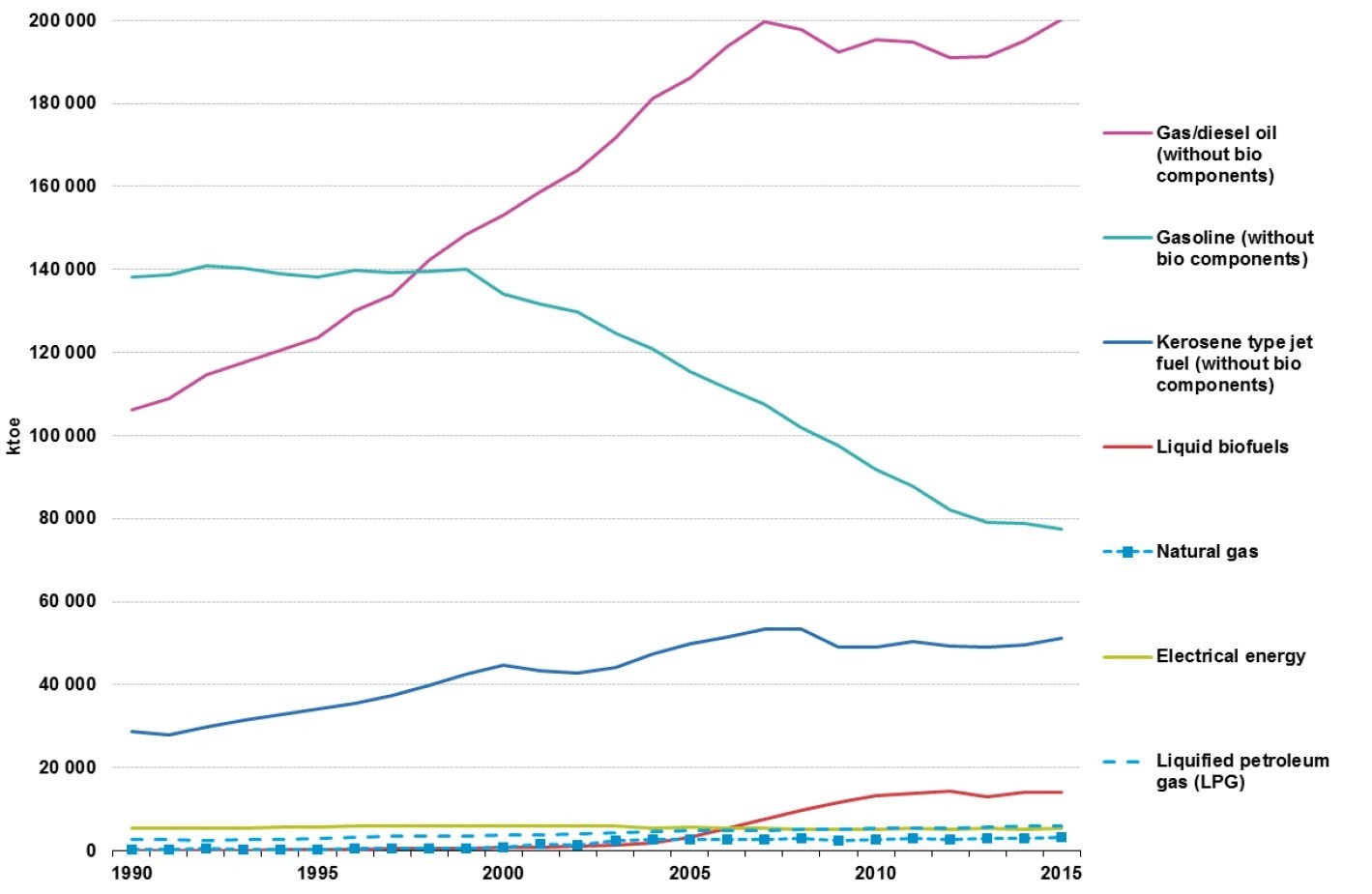 The share of diesel fuel in the EU transport sector has been on a steady incline since at least 1990, and the total volume has nearly doubled. It has primarily replaced gasoline, which is approaching half of 1990 levels. Click on Photo to enlarge.
The share of diesel fuel in the EU transport sector has been on a steady incline since at least 1990, and the total volume has nearly doubled. It has primarily replaced gasoline, which is approaching half of 1990 levels. Click on Photo to enlarge.
Life Cycle Analysis
What’s most egregious is that the EU measures these emissions via life cycle assessment (LCA) on a tank-to-wheel (TTW) rather than on a well-to-wheel (WTW) or seed-to-wheel (STW) basis. This essential topic will be revisited in part three of this series, but all you need to understand is that to use TTW is to imply that the life cycle of an energy source begins only after you place it in your car.
WTW or STW measures the life cycle emissions of the fuel from the moment that the petroleum is taken from the well or from when the seeds are planted. This ‘cradle-to-grave’ LCA is applied to measure emissions (and other environmental impacts) from oil extraction or planting seeds through fuel combustion. For EVs, WTW analyses include the mining of metals for battery production, the power plant emissions from electricity generation (typically taken as the national average emissions per kilowatt produced), and the transmission losses throughout the grid.
By TTW standards, however, EVs are zero-emissions vehicles since the upstream emissions are ignored. It’s easy to see how this can be perceived as political favoritism for e-mobility and a slight toward market-ready biofuels.
Roles of Markets and Consumers
Furthermore, Sauter reiterated Lacerda’s point that he prefers market-based support policies rather than list-based pre-selection. He went even deeper into his market theory, adding that “Nobody needs biofuels. You get your fuel at the filling station and your electricity in the wall.”
It should be up to science and society to determine whether we really need bioenergy as a society, and the international researchers in attendance at the conferences spoke loudly and clearly, as a January 2017 poll showed that EU citizens overwhelmingly support conventional biofuels (69% to 15%). Once that’s settled, it should be up to legislators to support its market performance.
“There is no food vs. fuel issue in Europe. Corn prices are down and wheat prices are down,” Sauter added, referencing the overblown controversy at the heart of this downturn in support for low carbon fuels. He went on to say, more in defiance than in regret, “I was the guy who invested my money [in biofuels], but I would never do it again.”
Burton echoed Sauter’s sentiments. “Unless you’re included in legislation,” she said of the low carbon fuels industry, “you don’t stand a chance. And if you don’t have a market, then you just go home.”
She managed to eke out a slightly more optimistic tinge with her final catchy one-liner, “In the industry, we have two options: we need to succeed or we need to fail quickly and move on.”
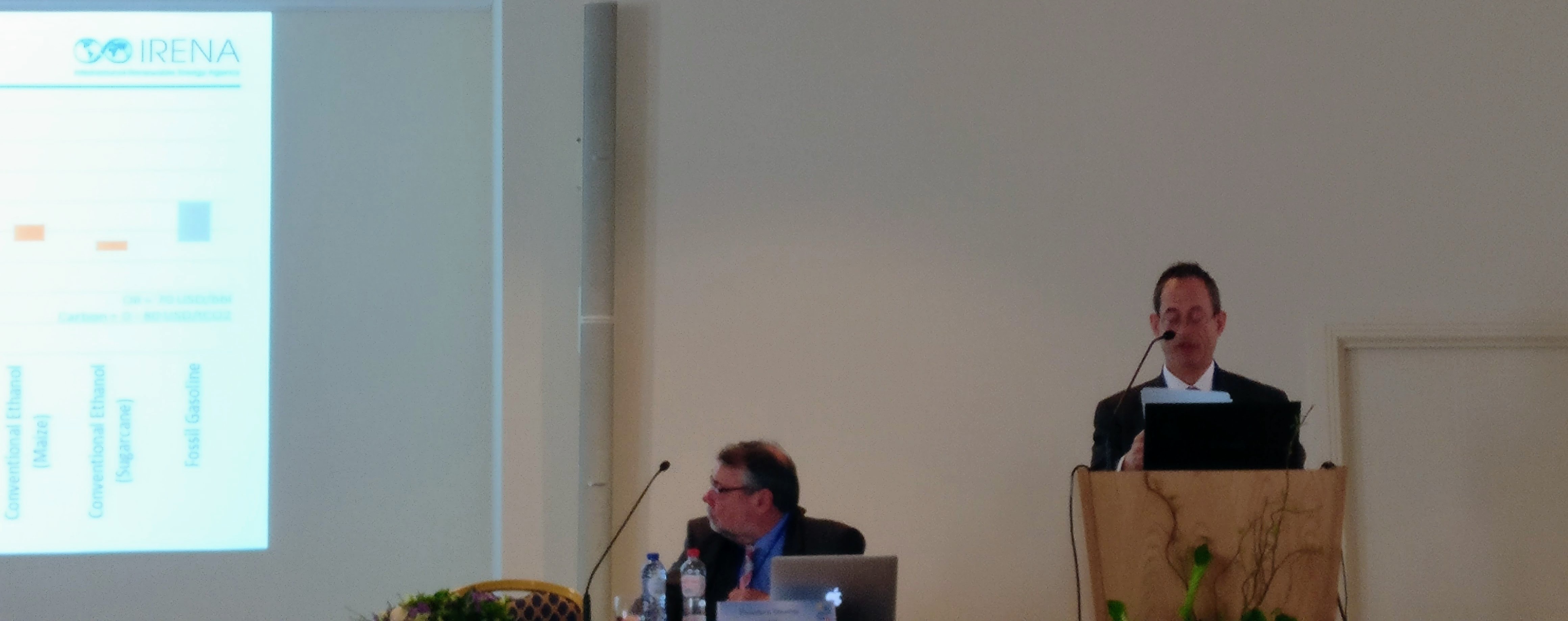 Jeff Skeer of IRENA (right) presents at the conference organized by the BioFuture Platform and hosted by the European Commission**
Jeff Skeer of IRENA (right) presents at the conference organized by the BioFuture Platform and hosted by the European Commission**
Flexing Supply-Side Muscle
As the discussions took on a more economic tone, Pete Harrison of the European Climate Foundation (ECF), a major climate action financier in Europe, urged us to distinguish between supply and demand when discussing possibilities and limits. On the supply side, he claims that there are clearly limits on what can be electrified in the next few decades, and thus there exists a significant gap to be filled with low carbon liquid fuels.
Benefits of Flex-ibility
In terms of capacity building opportunities, several panelists provided examples of not only flex crops but flex farms, flex facilities for bioprocessing and flex ventures in which first generation (1g) profits are invested into second generation (2g) production plants.
Jeff Skeer of the International Renewable Energy Agency (IRENA) spoke frequently about agroforestry, a flex farming practice of planting trees alongside short rotation crops. Not only does this increase the farm’s economic utility through market diversification but also very often by increasing crop yields.
The environmental benefits of this assisted symbiosis are also evident in its ability to increase soil carbon sequestration to greater levels compared to both typical cropland and natural forest. It wasn’t surprising then to hear Skeer chuckle that really, agroforestry may as well be the magic plant that Miguel Ivan Lacerda’s fictitious farmer discovered.
 Miguel Ivan Lacerda de Oliveira from the Brazilian Ministry of Mines and Energy presents a slide on the synergic effect of harvesting both the sugarcane crop (1g) along with its cellulosic residues (2g) for ethanol production. Energy-cane is a type of sugarcane with greater cellulosic fiber content, and this only projects to be cost-competitive by 2025 if we don’t restrict the conventional sugarcane industry now.**
Miguel Ivan Lacerda de Oliveira from the Brazilian Ministry of Mines and Energy presents a slide on the synergic effect of harvesting both the sugarcane crop (1g) along with its cellulosic residues (2g) for ethanol production. Energy-cane is a type of sugarcane with greater cellulosic fiber content, and this only projects to be cost-competitive by 2025 if we don’t restrict the conventional sugarcane industry now.**
Moreover, studies have found that intercropping - growing two or more species on the same plot of land - certain ‘fuel’ crops with ‘food’ crops also leads to higher yields. Naturally, this efficient farming technique reduces land use requirements and is even thought to be the most effective and lucrative method for reclaiming marginal land, doubly mitigating the dreaded ILUC (indirect land use change) factor.
A prime example of a flex venture is Ethanol Europe, who proclaim that they will be the EU’s leading producer of 2g ethanol by next year, and yet they are much more concerned with the 1g biofuels debate, judging from their highly vocal representatives in the audience.
Clariant, a climate-award-winning chemical and minerals company now branching into cellulosic residue-based (2g) biofuels, is a prime example of how to diversify your product portfolio to afford flexibility in the market, offering solutions for 20 distinct industries (though not all of which are particularly sustainable). The company’s representative at the conference, Paolo Corvo, stressed the importance of retrofitting 1g biofuel plants in order to prevent stranded assets and to minimize capital expenditure (capex).
Harrison concurred with this assessment, reminding us that Dieselgate has led to massive stranded assets in the auto industry, and that 1g biofuel facilities shouldn’t end in the same fate given their ability to be retrofitted. However, he warned that EU policy is leading instead to plant closures and offered legislators one final piece of advice: “Let’s not screw this up a second time.”
(A controversial and perhaps somewhat unfair analysis of Dieselgate can lead one to the conclusion that the EU’s obsession with fuel economy standards and thus the dirty efficiency of the diesel engine was the unintentional drop of the ball into this deadly Rube Goldberg contraption. An even deeper critical interpretation of the events have led some to an even more scathing conclusion.)
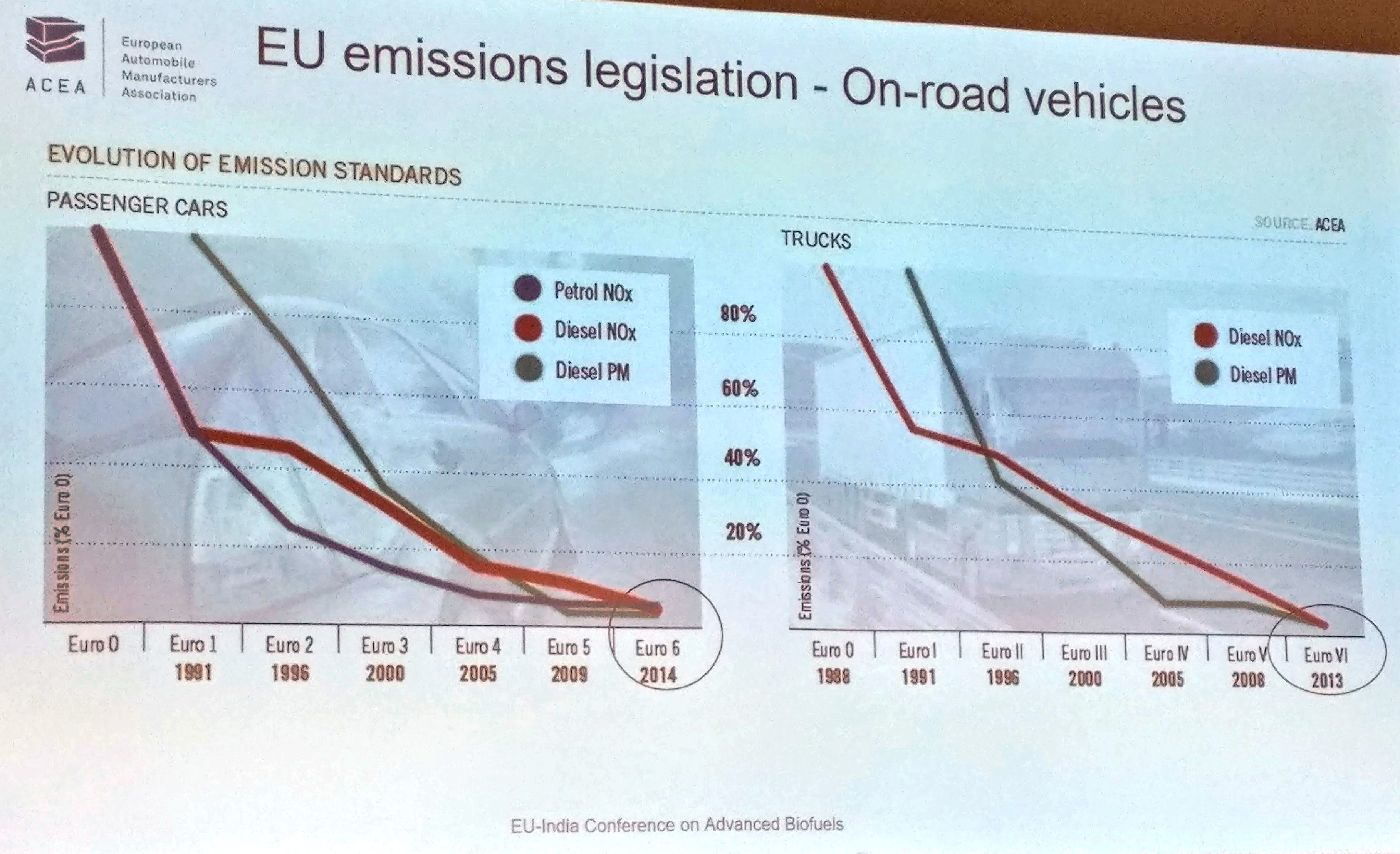 The leniency granted by the EU to NOx emissions from diesel cars compared to petrol cars is depicted in the graph on the left. Presented by Anders Röj of the European Automobile Manufacturers Association (ACEA) at the European Technology and Innovation Platform (ETIP) conference.**
The leniency granted by the EU to NOx emissions from diesel cars compared to petrol cars is depicted in the graph on the left. Presented by Anders Röj of the European Automobile Manufacturers Association (ACEA) at the European Technology and Innovation Platform (ETIP) conference.**
What about Demand-Side Flexibility?
Amidst all the excitement over the exploitable supply-side levers for driving a bioeconomy scale-up, I felt my hand shoot up reflexively as soon as the floor was opened up to questions. .
Flexibility is indeed crucial for the bioenergy market to move forward, and of course we should be leveraging existing technology and assets to their fullest, but aren’t we forgetting about the demand side and the end consumer’s role in all of this?
Flex-Fuel Plug-In Hybrid Electric Vehicles
Well, there exists a market-ready technology which could offer drivers more flexibility than any part of the supply chain, and the fact that it hasn’t made it to market is a mystery that has quite literally kept me up at night.
If over 90% of the cars in Brazil are flex fuel vehicles (FFVs), plug-in hybrid EVs (PHEVs) represented 49% of EV sales in the EU last year, and the same companies are serving both of these markets, why have we yet to see a single flex-fuel plug-in hybrid electric vehicle (FFPHEV)?
Though I can’t speak from personal experience in automotive engineering, the technical compatibility doesn’t seem to be a serious question since most gasoline engines manufactured after 1995 are safely and easily convertible to accept E85 (85% ethanol, 15% gasoline). Aftermarket conversion kits are widely available for purchase online.
Chevy Volt
In fact, the Chevrolet Volt, a pioneer of the PHEV market, takes just 5 minutes to be converted into an FFPHEV, as Chevy’s original intention was actually to release it as such. Now, a simple software tweak is all takes to open the door for owners to unparalleled freedom of choice - the ability to choose among electricity, gasoline, E30, E85, etc. depending on price, local availability, convenience, environmental responsibility or what-have-you, on a daily or weekly basis instead of locking themselves into a choice for a decade with a new car purchase.
My intuition tells me that Chevy had a two-fold rationale for holding out on this breakthrough technology. First, the public’s general ignorance toward ethanol and flex fuel technology renders the FFV feature relatively meaningless at the moment, and in turn could afford them the luxury of saving it for a future FFPHEV model line to capitalize on yet another “innovation”.
Second, the EU automotive market is more sensitive than ever to fuel economy, and FFVs generally offer lower miles per gallon. This is because ethanol, despite its higher octane performance (offering higher horsepower and torque) and cleaner emissions, has a lower energy density than gasoline. However, a properly optimized FFV engine (such as Ford’s Eco-Boost and GM’s Ecotec technologies) can actually deliver 97% of the fuel efficiency using E85 compared to E10 (the standard gasoline in US pumps today).
Therefore, Chevy (a GM brand) should be a prime candidate to spearhead the flex-fuel plug-in movement. However, if the industry doesn’t move quickly enough, perhaps policy should act preemptively with manufacturer tax incentives or government vehicle purchasing agreements for automakers who bring FFPHEVs to market.
This flexibility in consumer fuel demand also frees national governments to act in their best interests environmentally, economically and politically since they will not be beholden to a single industry for the supply of a basic necessity to their citizens.
Looking to the Future
A flex-fuel plug-in vehicle fleet would be capable of absorbing a future shift toward either biofuels or e-mobility without the need to scrap millions of vehicles before their end-of-life. If nothing else, it buys some time for the biofuels and e-mobility industries to mature until a clear winner can be chosen.
The trouble is, fuel efficiency is under the microscope largely due to well-intentioned but short-sighted governmental regulations in both the US and the EU. What really matters for the climate are the GHGs, not the MPGs (or Lge/100km for European readers), and this is another example (along with Dieselgate) of why policies must avoid confounding the importance of these two metrics.
Opinions from the Panel
Another explanation for why FFPHEVs have yet to enter the public eye is that the biofuels community has prioritized - some would say rightfully so - modes of transport which lack any alternative decarbonization pathways, such as aviation, maritime and freight transport; but light duty vehicles (LDVs, a.k.a. cars) represent the largest share of global mobility-related emissions.
Even if one argues that full electrification can provide the most promising future, there are still several decades between now and then during which electricity grids will remain carbon intensive, charging infrastructure will remain underdeveloped, and the market uptake of pure battery EVs will remain marginal.
This was the view of Damiana Serafini, Transport Manager at the World Business Council on Sustainable Development (WBCSD), who pointed out that regions like South America with a well-established bioeconomy and immense potential to continue developing the biofuels industry are unlikely to go with the full electrification route anytime soon.
This will of course hold truer for some geographical regions than others, but that’s a large part of the reason why we should be so concerned about flexibility.
In fact, this isn’t to say that highly climate-conscientious societies can be expected to dutifully transition to EVs either. Prof. Dr. Thomas Willner of the Hamburg University of Applied Sciences (HAW) relayed that German studies have all concluded that over 80% of the country’s road transport will still rely on liquid fuels in 2040/2050. There’s no reason to believe the German market wouldn’t favor low carbon fuels at a marginal price premium if EU and domestic policy would only get out of the way, Willner asserted.
Toyota Flex Fuel Prius Concept Car
The first direct answer to my suggestion of a vehicle that offers consumers the freedom of fuel choice came from Renato Godinho, the acting coordinator of the BioFuture Platform from the Brazilian Ministry of Foreign Affairs. He actually interjected from the audience that Toyota do Brasil had actually, just in the past month, released the first ever flex-fuel plug-in hybrid concept.
His excitement in the matter is certainly encouraging given his international leadership role, but as it turns out, this Brazilian/Japanese innovation doesn’t quite deliver on his claim. First, the Chevy Volt was the first-ever FFPHEV concept car to be released - all the way back in 2007. Second, my follow-up research found that the Toyota concept he was referring to is in fact just a standard Prius with flex fuel optimization.
Though certainly a step in the right direction, this innovation is frankly a decade too late. Toyota’s decision to omit the plug-in battery system limits the appeal and the lifespan of this model in markets which expect to move toward LDV electrification.
There is a theory within the e-mobility industry that the threshold for EVs to lose their ‘inconvenient’ and ‘range-limited’ labels is a charging time of 10 minutes or less. Dolf Gielen, the Director of Technology and Innovation at the International Renewable Energy Agency (IRENA), shared with me his confident opinion that the next generation of EV chargers will achieve that benchmark.
If this holds true, then the e-mobility revolution may truly take off within the coming decade, especially in places like China which needn’t rely on private investment for public charging infrastructure. In this scenario, any new model lines released without plug-in batteries are bound to become obsolete, and those investments stranded.
Nissan Solid-Oxide Fuel Cell Vehicle (e-Bio)
Miguel Ivan Lacerda was the only panel member to offer a response to my question, and instead of acknowledging the technological readiness of FFPHEVs, he took the opportunity to discuss a different intriguing technology which Nissan is pioneering, the solid-oxide fuel cell vehicle (the e-Bio Fuel Cell, essentially an ethanol-powered battery).
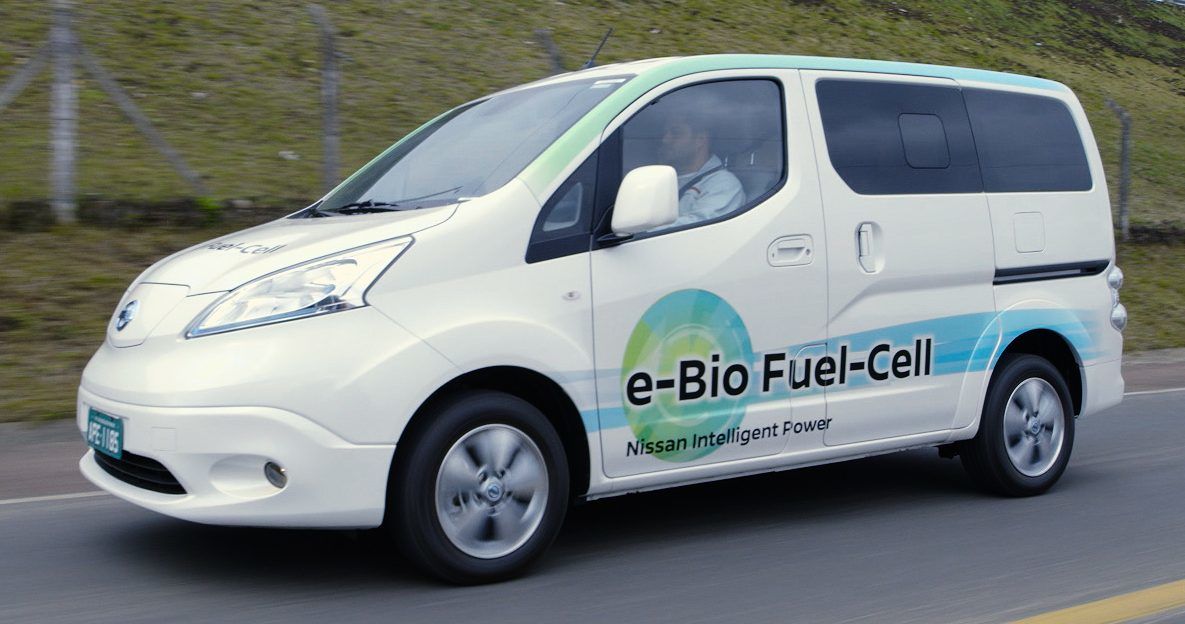 Nissan unveiled their e-Bio Fuel Cell concept, powered by a solid-oxide fuel cell (SOFC) which generates electricity from ethanol fuel, in June 2016.
Nissan unveiled their e-Bio Fuel Cell concept, powered by a solid-oxide fuel cell (SOFC) which generates electricity from ethanol fuel, in June 2016.
These cars would offer the range and fueling speed of liquid fuels combined with the conversion efficiency of an EV - the best of both worlds, Lacerda exclaimed. However, in a world which moves toward electrification, these may never see the outside of a concept car convention.
So... what’s in it for me?
For automakers, my point is that the potential return on investment for FFPHEVs - especially given the minimal investment cost - far exceeds that of both the e-Bio Fuel Cell and the flex fuel Prius since its utility is not limited to markets which adopt an ethanol-dominant transport system.
For households, a flex-fuel plug-in can protect the family against any market movements or changes in national transport policy or global energy politics in the decades following their new car purchase.
For national governments, the population’s flexible absorptive capacity for alternative mobility futures can aid in both economic optimization and political leverage for trade and geopolitical affairs in the future.
For society, this technology can help to wean us off our oil addiction while avoiding a technological lock-in moving forward. It’s not that FFPHEVs are the be-all end-all, it’s that they are the most elegant solution to wit that are immediately street-ready and future-proof at the very least out to mid-century.
Flexibility may seem like an alien concept for those of us who grew up within rigid institutions which conditioned us to believe that we need oil to fuel our vehicles (when the original internal combustion engine was actually designed for ethanol) and that farmland should only produce one crop at a time. It’s time that we begin to break these molds.
Similarly, these societally constricted thought patterns often lead us to debate whether we should choose biofuels or electrification for the future of transport, but the majority opinion of the Brussels conference attendees would argue that this is a fallacy.
The consensus of the international bioenergy, climate research and automotive communities alike is that we will need both biofuels and e-mobility if we hope to foster a sustainable future without severely limiting our capability to travel and transport goods.
Just as bioenergy suppliers are beginning to discover synergies between first and second generation biofuel production, FFPHEVs are capable of realizing a demand-side synergy between biofuels and battery technology here and now.
*Steve Bi is a graduate of the Centre international de formation européenne’s (CIFE) Master in Global Energy Transition and Governance and writes for Advanced Biofuels USA, particularly on policy developments in the EU.
**Photos by Steve Bi
Nearly 55,000 articles in our online library!
Use the categories and tags listed below to access the nearly 50,000 articles indexed on this website.
Advanced Biofuels USA Policy Statements and Handouts!
- For Kids: Carbon Cycle Puzzle Page
- Why Ethanol? Why E85?
- Just A Minute 3-5 Minute Educational Videos
- 30/30 Online Presentations
- “Disappearing” Carbon Tax for Non-Renewable Fuels
- What’s the Difference between Biodiesel and Renewable (Green) Diesel? 2020 revision
- How to De-Fossilize Your Fleet: Suggestions for Fleet Managers Working on Sustainability Programs
- New Engine Technologies Could Produce Similar Mileage for All Ethanol Fuel Mixtures
- Action Plan for a Sustainable Advanced Biofuel Economy
- The Interaction of the Clean Air Act, California’s CAA Waiver, Corporate Average Fuel Economy Standards, Renewable Fuel Standards and California’s Low Carbon Fuel Standard
- Latest Data on Fuel Mileage and GHG Benefits of E30
- What Can I Do?
Donate
DonateARCHIVES
- December 2025
- November 2025
- October 2025
- September 2025
- August 2025
- July 2025
- June 2025
- May 2025
- April 2025
- March 2025
- February 2025
- January 2025
- December 2024
- November 2024
- October 2024
- September 2024
- August 2024
- July 2024
- June 2024
- May 2024
- April 2024
- March 2024
- February 2024
- January 2024
- December 2023
- November 2023
- October 2023
- September 2023
- August 2023
- July 2023
- June 2023
- May 2023
- April 2023
- March 2023
- February 2023
- January 2023
- December 2022
- November 2022
- October 2022
- September 2022
- August 2022
- July 2022
- June 2022
- May 2022
- April 2022
- March 2022
- February 2022
- January 2022
- December 2021
- November 2021
- October 2021
- September 2021
- August 2021
- July 2021
- June 2021
- May 2021
- April 2021
- March 2021
- February 2021
- January 2021
- December 2020
- November 2020
- October 2020
- September 2020
- August 2020
- July 2020
- June 2020
- May 2020
- April 2020
- March 2020
- February 2020
- January 2020
- December 2019
- November 2019
- October 2019
- September 2019
- August 2019
- July 2019
- June 2019
- May 2019
- April 2019
- March 2019
- February 2019
- January 2019
- December 2018
- November 2018
- October 2018
- September 2018
- August 2018
- July 2018
- June 2018
- May 2018
- April 2018
- March 2018
- February 2018
- January 2018
- December 2017
- November 2017
- October 2017
- September 2017
- August 2017
- July 2017
- June 2017
- May 2017
- April 2017
- March 2017
- February 2017
- January 2017
- December 2016
- November 2016
- October 2016
- September 2016
- August 2016
- July 2016
- June 2016
- May 2016
- April 2016
- March 2016
- February 2016
- January 2016
- December 2015
- November 2015
- October 2015
- September 2015
- August 2015
- July 2015
- June 2015
- May 2015
- April 2015
- March 2015
- February 2015
- January 2015
- December 2014
- November 2014
- October 2014
- September 2014
- August 2014
- July 2014
- June 2014
- May 2014
- April 2014
- March 2014
- February 2014
- January 2014
- December 2013
- November 2013
- October 2013
- September 2013
- August 2013
- July 2013
- June 2013
- May 2013
- April 2013
- March 2013
- February 2013
- January 2013
- December 2012
- November 2012
- October 2012
- September 2012
- August 2012
- July 2012
- June 2012
- May 2012
- April 2012
- March 2012
- February 2012
- January 2012
- December 2011
- November 2011
- October 2011
- September 2011
- August 2011
- July 2011
- June 2011
- May 2011
- April 2011
- March 2011
- February 2011
- January 2011
- December 2010
- November 2010
- October 2010
- September 2010
- August 2010
- July 2010
- June 2010
- May 2010
- April 2010
- March 2010
- February 2010
- January 2010
- December 2009
- November 2009
- October 2009
- September 2009
- August 2009
- July 2009
- June 2009
- May 2009
- April 2009
- March 2009
- February 2009
- January 2009
- December 2008
- November 2008
- October 2008
- September 2008
- August 2008
- July 2008
- June 2008
- May 2008
- April 2008
- March 2008
- February 2008
- January 2008
- December 2007
- November 2007
- October 2007
- September 2007
- August 2007
- June 2007
- February 2007
- January 2007
- October 2006
- April 2006
- January 2006
- April 2005
- December 2004
- November 2004
- December 1987
CATEGORIES
- About Us
- Advanced Biofuels Call to Action
- Aviation Fuel/Sustainable Aviation Fuel (SAF)
- BioChemicals/Renewable Chemicals
- BioRefineries/Renewable Fuel Production
- Business News/Analysis
- Cooking Fuel
- Education
- 30/30 Online Presentations
- Competitions, Contests
- Earth Day 2021
- Earth Day 2022
- Earth Day 2023
- Earth Day 2024
- Earth Day 2025
- Executive Training
- Featured Study Programs
- Instagram TikTok Short Videos
- Internships
- Just a Minute
- K-12 Activities
- Mechanics training
- Online Courses
- Podcasts
- Scholarships/Fellowships
- Teacher Resources
- Technical Training
- Technician Training
- University/College Programs
- Events
- Coming Events
- Completed Events
- More Coming Events
- Requests for Speakers, Presentations, Posters
- Requests for Speakers, Presentations, Posters Completed
- Webinars/Online
- Webinars/Online Completed; often available on-demand
- Federal Agency/Executive Branch
- Agency for International Development (USAID)
- Agriculture (USDA)
- Commerce Department
- Commodity Futures Trading Commission
- Congressional Budget Office
- Defense (DOD)
- Air Force
- Army
- DARPA (Defense Advance Research Projects Agency)
- Defense Logistics Agency
- Marines
- Navy
- Education Department
- Energy (DOE)
- Environmental Protection Agency
- Federal Energy Regulatory Commission (FERC)
- Federal Reserve System
- Federal Trade Commission
- Food and Drug Administration
- General Services Administration
- Government Accountability Office (GAO)
- Health and Human Services (HHS)
- Homeland Security
- Housing and Urban Development (HUD)
- Interior Department
- International Trade Commission
- Joint Office of Energy and Transportation
- Justice (DOJ)
- Labor Department
- National Academies of Sciences Engineering Medicine
- National Aeronautics and Space Administration
- National Oceanic and Atmospheric Administration
- National Research Council
- National Science Foundation
- National Transportation Safety Board (NTSB)
- Occupational Safety and Health Administration
- Overseas Private Investment Corporation
- Patent and Trademark Office
- Securities and Exchange Commission
- State Department
- Surface Transportation Board
- Transportation (DOT)
- Federal Aviation Administration
- National Highway Traffic Safety Administration (NHTSA)
- Pipeline and Hazardous Materials Safety Admin (PHMSA)
- Treasury Department
- U.S. Trade Representative (USTR)
- White House
- Federal Legislation
- Federal Litigation
- Federal Regulation
- Feedstocks
- Agriculture/Food Processing Residues nonfield crop
- Alcohol/Ethanol/Isobutanol
- Algae/Other Aquatic Organisms/Seaweed
- Atmosphere
- Carbon Dioxide (CO2)
- Field/Orchard/Plantation Crops/Residues
- Forestry/Wood/Residues/Waste
- hydrogen
- Manure
- Methane/Biogas
- methanol/bio-/renewable methanol
- Not Agriculture
- RFNBO (Renewable Fuels of Non-Biological Origin)
- Seawater
- Sugars
- water
- Funding/Financing/Investing
- grants
- Green Jobs
- Green Racing
- Health Concerns/Benefits
- Heating Oil/Fuel
- History of Advanced Biofuels
- Infrastructure
- Aggregation
- Biofuels Engine Design
- Biorefinery/Fuel Production Infrastructure
- Carbon Capture/Storage/Use
- certification
- Deliver Dispense
- Farming/Growing
- Precursors/Biointermediates
- Preprocessing
- Pretreatment
- Terminals Transport Pipelines
- International
- Abu Dhabi
- Afghanistan
- Africa
- Albania
- Algeria
- Angola
- Antarctica
- Arctic
- Argentina
- Armenia
- Aruba
- Asia
- Asia Pacific
- Australia
- Austria
- Azerbaijan
- Bahamas
- Bahrain
- Bangladesh
- Barbados
- Belarus
- Belgium
- Belize
- Benin
- Bermuda
- Bhutan
- Bolivia
- Bosnia and Herzegovina
- Botswana
- Brazil
- Brunei
- Bulgaria
- Burkina Faso
- Burundi
- Cambodia
- Cameroon
- Canada
- Caribbean
- Central African Republic
- Central America
- Chad
- Chile
- China
- Colombia
- Congo
- Congo, Democratic Republic of
- Costa Rica
- Croatia
- Cuba
- Cyprus
- Czech Republic
- Denmark
- Dominican Republic
- Dubai
- Ecuador
- Egypt
- El Salvador
- Equatorial Guinea
- Estonia
- Eswatini/Swaziland
- Ethiopia
- European Union (EU)
- Fiji
- Finland
- France
- French Guiana
- Gabon
- Georgia
- Germany
- Ghana
- Global South
- Greece
- Greenland
- Grenada
- Guatemala
- Guinea
- Guyana
- Haiti
- Honduras
- Hong Kong
- Hungary
- Iceland
- India
- Indonesia
- Iran
- Iraq
- Ireland
- Israel
- Italy
- Ivory Coast
- Jamaica
- Japan
- Jersey
- Jordan
- Kazakhstan
- Kenya
- Korea
- Kosovo
- Kuwait
- Laos
- Latin America
- Latvia
- Lebanon
- Liberia
- Lithuania
- Luxembourg
- Macedonia
- Madagascar
- Malawi
- Malaysia
- Maldives
- Mali
- Malta
- Marshall Islands
- Mauritania
- Mauritius
- Mexico
- Middle East
- Moldova
- Monaco
- Mongolia
- Morocco
- Mozambique
- Myanmar/Burma
- Namibia
- Nepal
- Netherlands
- New Guinea
- New Zealand
- Nicaragua
- Niger
- Nigeria
- North Africa
- North America
- North Korea
- Northern Ireland
- Norway
- Oman
- Pakistan
- Panama
- Papua New Guinea
- Paraguay
- Peru
- Philippines
- Poland
- Portugal
- Qatar
- Republic of
- Romania
- Russia
- Rwanda
- Saudi Arabia
- Scotland
- Senegal
- Serbia
- Sierra Leone
- Singapore
- Slovakia/Slovak Republic
- Slovenia
- Solomon Islands
- South Africa
- South America
- South Korea
- South Sudan
- Southeast Asia
- Spain
- Sri Lanka
- Sudan
- Suriname
- Sweden
- Switzerland
- Taiwan
- Tanzania
- Thailand
- Timor-Leste
- Togo
- Trinidad and Tobago
- Tunisia
- Turkey
- Uganda
- UK (United Kingdom)
- Ukraine
- United Arab Emirates UAE
- Uruguay
- Uzbekistan
- Vatican
- Venezuela
- Vietnam
- Wales
- Zambia
- Zanzibar
- Zimbabwe
- Marine/Boat Bio and Renewable Fuel/MGO/MDO/SMF
- Marketing/Market Forces and Sales
- Opinions
- Organizations
- Original Writing, Opinions Advanced Biofuels USA
- Policy
- Presentations
- Biofuels Digest Conferences
- DOE Conferences
- Bioeconomy 2017
- Bioenergy2015
- Biomass2008
- Biomass2009
- Biomass2010
- Biomass2011
- Biomass2012
- Biomass2013
- Biomass2014
- DOE Project Peer Review
- Other Conferences/Events
- R & D Focus
- Carbon Capture/Storage/Use
- Co-Products
- Feedstock
- Logistics
- Performance
- Process
- Vehicle/Engine/Motor/Aircraft/Boiler/Ship
- Yeast
- Railroad/Train/Locomotive Fuel
- Resources
- Books Web Sites etc
- Business
- Definition of Advanced Biofuels
- Find Stuff
- Government Resources
- Scientific Resources
- Technical Resources
- Tools/Decision-Making
- Rocket/Missile Fuel
- Sponsors
- States
- Alabama
- Alaska
- Arizona
- Arkansas
- California
- Colorado
- Connecticut
- Delaware
- Florida
- Georgia
- Hawai'i
- Idaho
- Illinois
- Indiana
- Iowa
- Kansas
- Kentucky
- Louisiana
- Maine
- Maryland
- Massachusetts
- Michigan
- Midwest
- Minnesota
- Mississippi
- Missouri
- Montana
- Native American tribal nation lands
- Nebraska
- Nevada
- New Hampshire
- New Jersey
- New Mexico
- New York
- North Carolina
- North Dakota
- Ohio
- Oklahoma
- Oregon
- Pennsylvania
- Puerto Rico
- Rhode Island
- South Carolina
- South Dakota
- Tennessee
- Texas
- Utah
- Vermont
- Virginia
- Washington
- Washington DC
- West Coast
- West Virginia
- Wisconsin
- Wyoming
- Sustainability
- Uncategorized
- What You Can Do
tags
© 2008-2023 Copyright Advanced BioFuels USA. All Rights reserved.


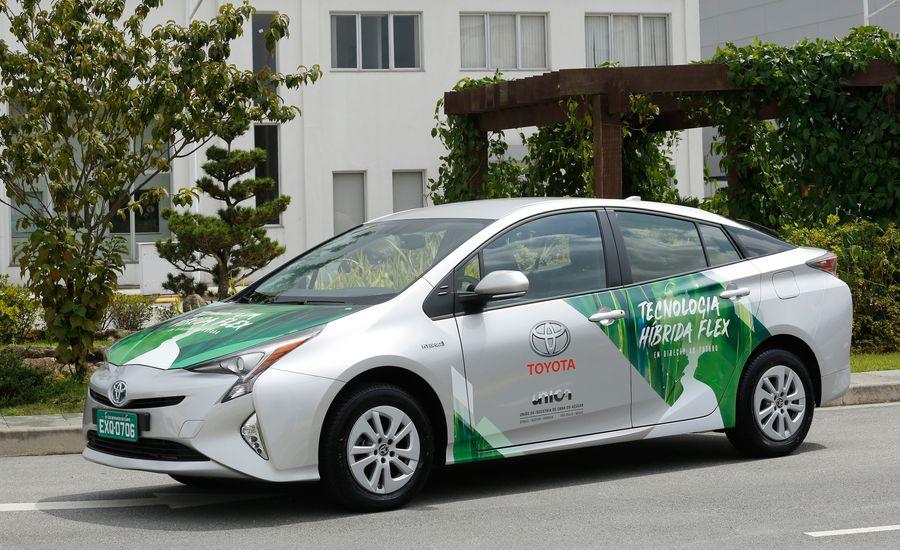
.jpg)





0 COMMENTS
Leave A Comment
Your Email Address wiil not be Published. Required Field Are marked*